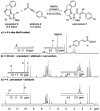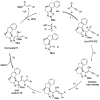α,β-Unsaturated acyl azoliums from N-heterocyclic carbene catalyzed reactions: observation and mechanistic investigation
- PMID: 21308930
- PMCID: PMC3189509
- DOI: 10.1002/anie.201005352
α,β-Unsaturated acyl azoliums from N-heterocyclic carbene catalyzed reactions: observation and mechanistic investigation
Abstract
Catalytically generated acyl azoliums I and their α,β-unsaturated counterparts II are thought to be key reactive intermediates in a rapidly growing number of transformations promoted by N-heterocyclic carbene (NHC) catalysts.[1] Acyl azoliums are invoked in the postulated catalytic cycles of nearly all of the new NHC-catalyzed reactions of α-functionalized aldehydes reported since 2004, in which they are generally assumed to possess the reactivity of an activated carboxylic acid, that is, analogous to an activated ester.[2] In NHC-catalyzed processes, they are most often obtained through internal redox reactions of functionalized aldehydes but have also been prepared by oxidations of the Breslow intermediates[3] or additions to ketenes.[4] Acyl azoliums I are important intermediates in thiamine pyrophosphate (ThPP) dependent enzymatic reactions.[5] Townsend et al. have recently proposed that unsaturated acyl azolium III is the key intermediate in clavulanic acid biosynthesis;[6] despite careful efforts, III or its analogues II have never been characterized or independently synthesized. Here, we document the observation and characterization of α,β-unsaturated acyl azoliums 1 and 2 (Scheme 1) and demonstrate that their corresponding hemiacetals (1′ and 2”) are the kinetically important intermediates in both their acylation and annulation reactions.
Figures









Similar articles
-
N-Heterocyclic carbene-catalyzed (4+2) cycloaddition/decarboxylation of silyl dienol ethers with α,β-unsaturated acid fluorides.J Am Chem Soc. 2011 Apr 6;133(13):4694-7. doi: 10.1021/ja111067j. Epub 2011 Mar 10. J Am Chem Soc. 2011. PMID: 21391673
-
N-heterocyclic carbene-catalyzed [3+4] cycloaddition and kinetic resolution of azomethine imines.J Am Chem Soc. 2014 Jan 29;136(4):1214-7. doi: 10.1021/ja411110f. Epub 2014 Jan 16. J Am Chem Soc. 2014. PMID: 24422593
-
Catalytic MBH reaction of β-substituted nitroalkenes with azodicarboxylates.Org Biomol Chem. 2013 Sep 14;11(34):5722-6. doi: 10.1039/c3ob40804c. Org Biomol Chem. 2013. PMID: 23884292
-
N-Heterocyclic carbene-catalyzed enantioselective synthesis of functionalized cyclopentenes via α,β-unsaturated acyl azoliums.Chem Commun (Camb). 2014 Dec 4;50(93):14539-42. doi: 10.1039/c4cc07433e. Chem Commun (Camb). 2014. PMID: 25307503
-
Carbene catalysts.Top Curr Chem. 2010;291:77-144. doi: 10.1007/978-3-642-02815-1_18. Top Curr Chem. 2010. PMID: 21494949 Free PMC article. Review.
Cited by
-
A cooperative N-heterocyclic carbene/chiral phosphate catalysis system for allenolate annulations.Angew Chem Int Ed Engl. 2014 Jul 14;53(29):7594-8. doi: 10.1002/anie.201403446. Epub 2014 Jun 4. Angew Chem Int Ed Engl. 2014. PMID: 24895280 Free PMC article.
-
Chiral N-Heterocyclic Carbene Catalyzed Annulations of Enals and Ynals with Stable Enols: A Highly Enantioselective Coates-Claisen Rearrangement.ACS Catal. 2012;2(2):494-503. doi: 10.1021/cs300020t. Epub 2012 Feb 29. ACS Catal. 2012. PMID: 22468232 Free PMC article.
-
Asymmetric Organocatalysis: The Emerging Utility of α,β-Unsaturated Acylammonium Salts.Angew Chem Int Ed Engl. 2016 Nov 2;55(45):13934-13943. doi: 10.1002/anie.201602217. Epub 2016 Sep 21. Angew Chem Int Ed Engl. 2016. PMID: 27650693 Free PMC article. Review.
-
Asymmetric catalytic [1,3]- or [3,3]-sigmatropic rearrangement of 3-allyloxy-4H-chromenones and their analogues.Chem Sci. 2024 Jun 19;15(28):11005-11012. doi: 10.1039/d4sc02201g. eCollection 2024 Jul 17. Chem Sci. 2024. PMID: 39027306 Free PMC article.
-
Organocatalytic Reactions Enabled by N-Heterocyclic Carbenes.Chem Rev. 2015 Sep 9;115(17):9307-87. doi: 10.1021/acs.chemrev.5b00060. Epub 2015 May 20. Chem Rev. 2015. PMID: 25992594 Free PMC article. Review.
References
-
- Moore JL, Rovis T. In: Topics in Current Chemistry. List B, editor. Vol. 291. Springer; Berlin: 2009. pp. 77–144. - PMC - PubMed
- Enders D, Niemeier O, Henseler A. Chem Rev. 2007;107:5606–5655. - PubMed
- Zeitler K. Angew Chem. 2005;117:7674–7678.
- Angew Chem Int Ed. 2005;44:7506–7510. - PubMed
- Enders D, Balensiefer T. Acc Chem Res. 2004;37:534–541. - PubMed
- Chiang PC, Bode JW. In: N-Heterocyclic Carbenes: From Laboratory Curiosities to Efficient Synthetic Tools. Díez-González S, editor. Royal Society of Chemistry; Cambridge: 2010. pp. 399–435.
-
- Sohn SS, Rosen EL, Bode JW. J Am Chem Soc. 2004;126:14370–14371. - PubMed
- Reynolds NT, Read de Alaniz J, Rovis T. J Am Chem Soc. 2004;126:9518–9519. - PubMed
- Chow KYK, Bode JW. J Am Chem Soc. 2004;126:8126–8127. - PubMed
- Burstein C, Glorius F. Angew Chem. 2004;116:6331–6334. - PubMed
- Angew Chem Int Ed. 2004;43:6205–6208. - PubMed
Publication types
MeSH terms
Substances
Grants and funding
LinkOut - more resources
Full Text Sources

